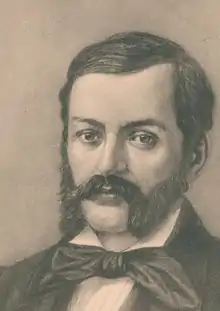Bogoboj Atanacković
Bogoboj Atanacković (Serbian Cyrillic: Богобој Атанацковић; Baja, 10 June 1826 – Baja, 28 July 1858) was a Serbian writer.[1] Atanacković who, encouraged by the ideas of romanticism, changed his name Timotej into Bogoboj for artistic reasons at the age of eighteen.

Biography
Atanacković was from a very respectable bourgeois family, where Serbian tradition was honoured scrupulously. He started school at an early age in his village. He attended high school at the Gymnasium of Karlovci before pursuing higher studies at the universities of the Hungarian and Austrian capitals.
Atanacković resumed his law studies, which he had begun at universities in Budapest and in Vienna, where he frequented the circle of Serbian romanticists, followers of Vuk Karadžić; he was friends with Đuro Daničić and poet Branko Radičević. As a result of his participation in the Serbian Movement of 1848 and at the May Assembly in Sremski Karlovci, he was forced to flee to Vienna and later to Paris, from where he travelled throughout France, Switzerland, Germany, England and Italy. He came to Novi Sad in 1851 and worked as a secretary of the Orthodox bishop, Platon Atanacković. He continued his literary work, which he had started during his studies in Vienna, and in 1852 he returned to Baja, where he opened a law office.[1] He died in 1858 of tuberculosis. He was 32.
He posed for a portrait when he was around fourteen, probably at the end of the first years of high school, a child from a respectable merchant family in Baja; the portraitist was either of Austrian or Hungarian origin, but his identity still remains unknown. Atanacković was painted with a book in his right hand, in a manner customary at the time for portraits of older children who attended school or came from educated families. He was predestined to study law. Neither a child, nor an adult, with a serious expression on his face, but with the size of a child, clothed according to the style of the upper classes, bourgeoisie or nobility (Artist Jovan Popović painted the portrait of distinguished and ageing Sava Tekelija wearing such clothes), the future lawyer was depicted in a typical, slightly stiff pose, characteristic of a Biedermeier painting. His body and his arms are somewhat disproportionate to his head, but his face is painted carefully, with extraordinary warmth and directness. The details on his clothes - the decorative stripes, the buttons, the folds of his coat, the bow on his shirt - are accentuated in their simplicity to emphasize the importance of the depicted person.
"Dva idola (1851)" made him famous. He suddenly found himself in demand as a novelist of the first order. Today Atanacković is not looked upon that way by current critics, but then we're living in a different time. His stories are in part autobiographical or based on lives of people he knew: to invent for him was to remember. His stories usually had a foundation in fact and, in addition, his choice of realistic detail within loosely spun plots gave his work an air of verisimilitude. Even so, he achieved his effects by his "easy, plain, and familiar language of the common folk," taught him by Karadzić and Daničić when he was studying in Vienna for his law degree.
Bogoboj Atanacković brought to the Serbian novel a sense of tragic pessimism expressed with stoic restraint. Nothing in his external circumstances of his life explains this point of view, except for the current events which he witnessed a wrote about both in the guise of his novels, sentimental patriotic stories, and autobiography. He was brought up in [[Baja, Hungary]], and his closeness to simple rural life probably helped him to penetrate to the central motives of existence. After travelling through Western Europe for two years, Atanackovic settled in Novi Sad, preferring to try his hand at writing novels than practicing law. In subsequent novels his world became increasingly one of grim tereenism—crass casualty—equally devoid of divine intent and of materialistic logic. Chance, accident, coincidence determine the outcome of human effort in his case, and the case for most of us.
As a novelist and short story writer Bogoboj Atanacković came to hold definite theories of the purposes and values of fiction, which he set forth in the essays collected after his death in the "Collection of the Works by Bogoboj Atanacković."
Legacy
On the ground of literary reception of Bogoboj Atanacković's work, according to Jovan Skerlić, it has been found out that he belongs to a group of writers who were at the beginning praised too much, and later on completely disdained. Atanacković aimed to educate and entertain his readers, and the attitudes he supports in his poetics shows that he was familiar with the contemporary pedagogical teachings. He was writing for the female part of his audience and for the youth. Atanacković was influenced by Serbian writers of the previous epochs along with his contemporaries, first of all Branko Radičević, also the contemporary Russian, French, German and Hungarian writers, as well as the oral folk and urban lyrics. In his works he described the events of the 1848-1849 Revolution. His contribution to the development of Serbian literature is seen in abandoning the Vojvodina dialect in accordance with Vuk Karadžić's reform of the Serbian language, combining the sentimental and romantic style with the elements of realism in the Serbian prose, also in turning to the themes from contemporary life and including the social aspects into the literature, while in the prose accounts of his travels he used meditative reporter style and the epistle form.
References
- Translated and adapted from Jovan Skerlić's Istorija nove srpske književnosti (Belgrade, 1914, 1921) pages 288-291.
- Stefan Barbarič (1971). Živan Milisavac (ed.). Jugoslovenski književni leksikon [Yugoslav Literary Lexicon] (in Serbo-Croatian). Novi Sad (SAP Vojvodina, SR Serbia): Matica srpska. p. 22.